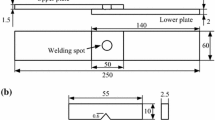Abstract
Novel hybrid refill friction stir spot welding (RFSSW) assisted with ultrasonic oscillation was introduced to 5A06 aluminum alloy joints. The metallographic structure and mechanical properties of 5A06 aluminum alloy RFSSW joints formed without ultrasonic assistance and with lateral and longitudinal ultrasonic assistance were compared, and the ultrasonic-assisted RFSSW process parameters were optimized. The results show that compared with lateral ultrasonic oscillation, longitudinal ultrasonic oscillation strengthens the horizontal bonding ligament in the joint and has a stronger effect on the joint’s shear strength. By contrast, lateral ultrasonic oscillation strengthens the vertical bonding ligament and is more effective in increasing the joint’s tensile strength. The maximum shear strength of ultrasonic-assisted RFSSW 5A06 aluminum alloy joints is as high as 8761 N, and the maximum tensile strength is 3679 N when the joints are formed at a tool rotating speed of 2000 r/min, a welding time of 3.5 s, a penetration depth of 0.2 mm, and an axial pressure of 11 kN.
Similar content being viewed by others
References
C. Schilling and J.D. Santos, Device for Joining by Friction Stir Welding at least Two Workpieces, US patent, Appl. 6604667 B2, 2003.
C. Schilling and J.D. Santos, Method and Device for Joining at least Two Adjoining Work Pieces by Friction Welding, US patent, Appl. 6722556 B2, 2004.
X.W. Yang, T. Fu, and W.Y. Li, Friction stir spot welding: a review on joint macro-and microstructure, property, and process modelling, Adv. Mater. Sci. Eng., 2014(2014), p. 1.
T. Rosendo, B. Parra, M.A.D. Tier, A.A.M. Silva, J.F. dos Santos, and T.R. Strohaecker, Mechanical and microstructural investigation of friction spot welded AA6181–T4 aluminium alloy, Mater. Des., 32(2011), No. 3, p. 1094.
K.H. Muci-Küchler, E. Saint, J. Street, W.J. Arbegast, E. Saint, and J. Street, Simulation of a refill friction stir spot welding process using a fully coupled thermo-mechanical FEM model, J. Manuf. Sci. Eng., 132(2010), No. 1, p. 1.
S.J. Prakash and S. Muthukumaran, Refilling probe hole of friction spot joints by friction forming, Adv. Mater. Manuf. Process., 26(2011), No. 12, p. 1539.
T. Iwashita, Method and Apparatus for Joining, US patent, Appl. 6601751 B2, 2003.
N.T. Nguyen, D.Y. Kim, and H.Y. Kim, Assessment of the failure load for an AA6061–T6 friction stir spot welding joint, J. Eng. Manuf., 225(2011), No. 10, p. 1746.
W.J. Arbegast, Friction stir welding after a decade of development, Weld. J., 85(2006), No. 3, p. 28.
Y. Uematsu, K. Tokaji, Y. Tozaki, T. Kurita, and S. Murata, Effect of re-filling probe hole on tensile failure and fatigue behaviour of friction stir spot welded joints in Al–Mg–Si alloy, Int. J. Fatigue, 30(2008), No. 10-11, p. 1956.
Z. Shen, X. Yang, S. Yang, Z. Zhang, and Y Yin, Microstructure and mechanical properties of friction spot welded 6061–T4 aluminum alloy, Mater. Des., 54(2014), No. 2, p. 766.
Z. Shen, X. Yang, Z. Zhang, L. Cui, and T. Li, Microstructure and failure mechanisms of refill friction stir spot welded 7075–T6 aluminum alloy joints, Mater. Des., 44(2013), p. 476.
S.S.F. Chang and G.M. Bone, Burr size reduction in drilling by ultrasonic assistance, Rob. Comput. Integr. Manuf., 21(2005), No. 4-5, p. 442.
R. Singh and J.S. Khamba, Ultrasonic machining of titanium and its alloys: a review, J. Mater. Process. Technol., 173(2006), No. 2, p. 125.
R. Neugebauer and A. Stoll, Ultrasonic application in drilling, J. Mater. Process. Technol., 149(2004), No. 1-3, p. 633.
J. Tsujino, K. Hidai, A. Hasegawa, R. Kanai, H. Matsuura, K. Matsushima, and T. Ueoka, Ultrasonic butt welding of aluminum, aluminum alloy and stainless steel plate specimens, Ultrasonics, 40(2002), No. 1-8, p. 371.
Acknowledgments
This work was financially supported by Hunan Science and Technology Research Projects (Nos. 2016GK2021 and 2016TP1023) and Hunan Provincial Natural Science Foundation of China (No. 2016JJ4082). The authors also would like to thank Dr. Axel Meyer from Application and Technology Centre for Robotic Friction Welding who provided the assistance with the development of the spot welding device.
Author information
Authors and Affiliations
Corresponding author
Rights and permissions
About this article
Cite this article
Liu, Xb., Qiao, Fb., Guo, Lj. et al. Metallographic structure, mechanical properties, and process parameter optimization of 5A06 joints formed by ultrasonic-assisted refill friction stir spot welding. Int J Miner Metall Mater 24, 164–170 (2017). https://doi.org/10.1007/s12613-017-1391-8
Received:
Revised:
Accepted:
Published:
Issue Date:
DOI: https://doi.org/10.1007/s12613-017-1391-8




